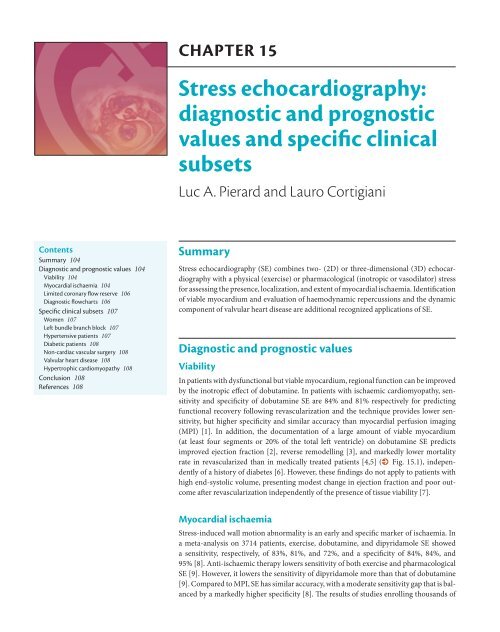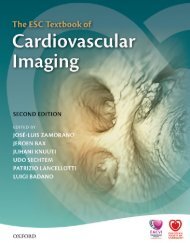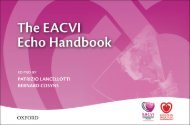EACVI Echocardiography Textbook - sample
Discover the EACVI Textbook of Echocardiography 2nd edition
Discover the EACVI Textbook of Echocardiography 2nd edition
You also want an ePaper? Increase the reach of your titles
YUMPU automatically turns print PDFs into web optimized ePapers that Google loves.
Chapter 15<br />
Stress echocardiography:<br />
diagnostic and prognostic<br />
values and specific clinical<br />
subsets<br />
Luc A. Pierard and Lauro Cortigiani<br />
Contents<br />
Summary 104<br />
Diagnostic and prognostic values 104<br />
Viability 104<br />
Myocardial ischaemia 104<br />
Limited coronary flow reserve 106<br />
Diagnostic flowcharts 106<br />
Specific clinical subsets 107<br />
Women 107<br />
Left bundle branch block 107<br />
Hypertensive patients 107<br />
Diabetic patients 108<br />
Non-cardiac vascular surgery 108<br />
Valvular heart disease 108<br />
Hypertrophic cardiomyopathy 108<br />
Conclusion 108<br />
References 108<br />
Summary<br />
Stress echocardiography (SE) combines two- (2D) or three-dimensional (3D) echocardiography<br />
with a physical (exercise) or pharmacological (inotropic or vasodilator) stress<br />
for assessing the presence, localization, and extent of myocardial ischaemia. Identification<br />
of viable myocardium and evaluation of haemodynamic repercussions and the dynamic<br />
component of valvular heart disease are additional recognized applications of SE.<br />
Diagnostic and prognostic values<br />
Viability<br />
In patients with dysfunctional but viable myocardium, regional function can be improved<br />
by the inotropic effect of dobutamine. In patients with ischaemic cardiomyopathy, sensitivity<br />
and specificity of dobutamine SE are 84% and 81% respectively for predicting<br />
functional recovery following revascularization and the technique provides lower sensitivity,<br />
but higher specificity and similar accuracy than myocardial perfusion imaging<br />
(MPI) [1]. In addition, the documentation of a large amount of viable myocardium<br />
(at least four segments or 20% of the total left ventricle) on dobutamine SE predicts<br />
improved ejection fraction [2], reverse remodelling [3], and markedly lower mortality<br />
rate in revascularized than in medically treated patients [4,5] (% Fig. 15.1), independently<br />
of a history of diabetes [6]. However, these findings do not apply to patients with<br />
high end-systolic volume, presenting modest change in ejection fraction and poor outcome<br />
after revascularization independently of the presence of tissue viability [7].<br />
Myocardial ischaemia<br />
Stress-induced wall motion abnormality is an early and specific marker of ischaemia. In<br />
a meta-analysis on 3714 patients, exercise, dobutamine, and dipyridamole SE showed<br />
a sensitivity, respectively, of 83%, 81%, and 72%, and a specificity of 84%, 84%, and<br />
95% [8]. Anti-ischaemic therapy lowers sensitivity of both exercise and pharmacological<br />
SE [9]. However, it lowers the sensitivity of dipyridamole more than that of dobutamine<br />
[9]. Compared to MPI, SE has similar accuracy, with a moderate sensitivity gap that is balanced<br />
by a markedly higher specificity [8]. The results of studies enrolling thousands of





